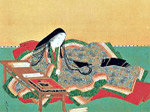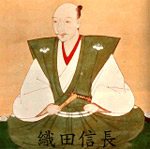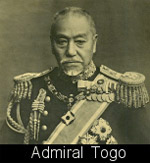Visual Arts: Painting II/ Asian Arts and Culture High School (Grades 9-12)
Objective
As a result of instruction, students will be able to…
- Use specific watercolor techniques in a sketchbook exercise.
- Identify common elements of Japanese scrolls.
- Create a watercolor painting using a Japanese theme of landscape, birds and flowers, or figures. Subject matter may also include religion.
- Add calligraphy to painting and present in a finished state as a hanging scroll or a hand scroll.
PA State Standards for Arts and Humanities
9.1.12: A,B,C,D,E,F,J
9.2.12: A,C,D,E,F,G,I,J,K,L
9.3.12: A,B,C,D,E,F
9.4.12: A,B,C,D
Materials
- Watercolor paper
- Sumi-e ink
- Ribbon Watercolor brushes
- Bamboo brushes
- PVC pipe
- Watercolor tape
- Wallpaper for scroll backing
- Elmer’s Glue
- Brush-up paper dowel rod
- Soap eraser
- X-acto knife
- Printing ink
- Tape/tape gun
Instructional Resources
- Scrolls brought back by instructor from Japan
- The Book of Art-Volume 9: Chinese and Japanese Art
- East Asia- A Cultural, Social and Political History (Ebrey)
- Instructional art books purchased in Japan
- Sumi-e The Art of Japanese Brush Painting (Syoko)
- Japanese Art in detail (Reeve)
Websites and Resources
Websites and Sources for Reference
- Traditional Japanese Painting
- Museum of Fine Arts Boston
- What Is Emaki?
- Kano School of Painting
- Book: Japanese Painting by Terukazu Akiyama (Rizzoli, 1977). Calligraphy Good Photos at Japan-Photo Archive
- Nadja Van Ghelue Calligraphy Site
- Shodo Designs
- Japanese Calligraphy
Websites and Sources on Japanese Art
- Artelino on Japanese Art
- Japanese Art and Architecture from the Web Museum Paris
- Zeroland
- Asia Society Virtual Tour
- Daruma, Japanese Art and Antiques Magazine
Art History Sites
- Art History Resources on the Web – Japan
- Japanese Art History Resources
- Books: History of Japanese Art by Penelope Mason (Harry N. Abrams, 1993);
- The People’ Culture—from Kyoto to Edo by Yoshida Mitsukuni (Cosmo Public Relations Corporation, Tokyo, 1986);
- The Shaping of Daimyou Culture, 1185- 1868 by Martin Collcut and Yoshiaki Shimizu (National Gallery of Art, 1988).
Art Museums in Japan
- Columbia University Page on Collections of Japanese Art
- Tokyo National Museum site
- Tokugawa Art Museum
- National Museum of Japanese History
- Nara National Museum
- Kyoto University Museum
- National Museum of Art, Osaka
- National Research of Cultural Properties Tokyo
- National Research of Cultural Properties Nara
- Miho Museum near Kyoto
- Photos
Museums with Good Collections of Japanese Art Outside of Japan
- Columbia University Page on Collections of Japanese Art
- Metropolitan Museum of Art
- Sackler Museum in Washington
- Museum of Fine Arts, Boston
- British Museum
- Ruth and Sherman Lee Institute for Japanese Art Collection
Day 1: Background for lesson: Instructor’s trips to Japan
Japan Fulbright in 2005; Trinity High School Trip in 2012-accounts and anecdotes of trip; where scrolls and other sources were purchased; Photos taken in Japan of the use of calligraphy
Essential Questions (looking at visuals and actual Scrolls)
- What materials did the artist use to create a scroll?
- Why didn’t the artist use any color in many of the scrolls?
- How is nature depicted in Japanese landscape painting?
- Why did the artist choose different shapes for a painting?
- What is this image about? (in the scroll shown)
- What does the calligraphy on the scroll mean?
- How does the calligraphy relate to the scroll?
- Why are red stamps placed all over this painting?
Day 2: History and background of Japanese Scrolls
Many Japanese masterpieces are painted on scrolls, which are not intended to be hung or mounted on walls, but rather are meant to be stored in boxes and periodically taken out be looked at. This helps preserve the frail paint which breaks down when exposed to humidity and air. Collectors have traditionally unrolled their scrolls after the rainy season in the summer, savored them with some tea and returned them their boxes. Scrolls unfortunately are one of the world’s most fragile art forms. Careless handling, exposure to bright light and humidity, inept restoration, insects, temperature changes all contribute to the deterioration of paint. Plus, silk is a protein-based animal fiber that breaks down over time and has damaging chemical reactions with pigments and glues. Western oil paintings, by contrast, last longer because the pigments are preserved in oil and protected from by the elements by varnish.
 The Heian Period (794 – 1192)
The Heian Period (794 – 1192)
The most original style of Japanese hanging scroll came from China. In the Early China, Buddhist missionaries carried Buddhistic paintings to spread their religion.
Until the reign of Tang regime (618-907) of China, that kind of Buddhistic paintings were used to be decorated and reinforced to be proof enough for carrying.
That’s the archetype of hanging scrolls.
After Buddhism was introduced to Japan, such a decoration style of paintings was also introduced in the Heian Period of Japan.
 The Muromachi Period (1334 – 1573)
The Muromachi Period (1334 – 1573)
During this period, Japan’s original housing architecture had quite developed.
In that architecture style, there is one special room that is called “Tokonoma”.
Most of artworks including hanging scrolls were displayed in this room. Tokonoma was regarded as the space which connects art and daily life. This is very original thought that can not be found in other countries.
 The Momoyama Period (1573 – 1600)
The Momoyama Period (1573 – 1600)
Two great sovereigns represent this period. Oda Nobunaga & Toyotomi Hideyoshi.
They liked “Chanoyu” (=tea ceremony) very much. Chanoyu ceremony was usually done in Tokonoma room.
Tokonoma architecture style was developed and established in this period.
Accompanied with the development of Tokonoma style, the techniques of painting and mounting were also developed because hanging scrolls were always displayed in Tokonoma room.
 The Edo Period (1603 – 1868)
The Edo Period (1603 – 1868)
There were only a few big wars in this period in Japan.
As this period was so peaceful, each Japanese culture had reached full maturity.
Many famous painters flourished and competed each other. Hanging scrolls also became popular among the public.
 After the Meiji Period (1868 – )
After the Meiji Period (1868 – )
Much more painters competed each other for their techniques because people became absolutely free to choose their occupations from this period.
Before World War 2, and for a while after that war, most of Japanese painting artworks were used to be decorated to hanging scrolls.
By reasons of the above, now, we can enjoy high-quality hanging scrolls made after the Meiji Period.
Characteristics of the Technique
- Brush technique: Lines play a decisive role in the formation of images in traditional Japanese painting, and the variations in lines are determined by the method of using the brush.
- Use of Ink: Ink occupies an exceedingly important position in traditional Japanese painting, whether it is figure painting, landscape painting or flower-and-bird painting- pure line drawing, ink-and-wash, light coloring or heavy coloring. Black is the main color of traditional Japanese painting, and black has five shades. The use of ink involves four processes: outlining showing the shades and texture of rocks and mountains by light ink stroke, applying dots, coloring and adding calligraphy
- Use of color: Color in Japanese painting is mostly used after finishing the basic modeling with brushwork and ink. It involves variations of brightness of the intrinsic colors, mutual contrast and harmonious relations between various intrinsic colors, coordination of brush-work and ink technique and consideration of colors’ textural functions on paper and silk. Traditional Japanese painting does not depict the complexities of light and color, but, all the same, it achieves truthful effect with exceedingly artistic appeal.
Traditional Materials
- Sumi-e Ink
- Paper and Silk
- Ink Slab
- Color Mixing tray
- Bamboo brushes
Day 3-4: Research and Sketching
- Student’s research schools of painting and subject matter (books and internet) sketch ideas for scrolls in pencil
- Ideas in preparation for painting
Day 5: Instruction
- Sketching on watercolor paper, preparation and stretching of paper; taping onto drawing board.
- Demonstration of “The Four Gentlemen” (bamboo, plum, orchid and chrysanthemum.)
Day 6-7
- Sketchbook exercises using watercolor techniques and unique painting medium and practicing “The Four Gentlemen”.
Day 8-15
- Work on watercolor paper/paint with liquid watercolor.
Day 16: Demonstration of Calligraphy
- Holding brush
- Brush Strokes
- Visuals: photos taken by instructor of Japanese/monks writing calligraphy at temples; Instructor’s Temple Book
Day 17-19
- Research calligraphy (Google Translate for translations from English to Japanese)
- Practice calligraphy with ink or water on zen board.
Day 20-22: Haiku Writing
Haiku are short poems that use sensory language to capture a feeling or image. They are often inspired by an element of nature, a moment of beauty or a poignant experience. Haiku poetry was originally developed by Japanese poets, and the form was adapted to English and other languages by poets in other countries.
- Students write Haiku
Day 23-26
- Review information regarding the seal on a scroll.
- Students use Google Translate to translate their names and haiku from English to Japanese. Draw characters on soap eraser and carve with x- acto knife.
- Print on scroll using block printing ink.
Day 27-29
- Write on scroll in ink
- Attach to wall paper using traditional wet mount technique
- Attach PVC pipe, dowel rod and ribbon
Day 30
- Critique: Discuss ideas, process and evaluate production
- Evaluative Criteria: subject matter, painting techniques, calligraphy, understanding of process, creativity, quality of work, effort, mounting to wallpaper and hanging.
Major Understandings
- The students will be able to recognize the achievement and contributions of the Japanese culture in art though the research gathered regarding the traditional painting and scroll
- The students will have an opportunity to examine actual artwork from Japan and develop an aesthetic appreciation for the craftsmanship of the individual pieces shown in the different scrolls.
- The students will be able to compare and contrast styles, art techniques, writing, culture, landscapes, etc of Japan in its relationship to western art, style, and culture.
- The student will be able to identify, distinguish and describe the different styles of Japanese scrolls and relate those features to the scrolls created by fellow students.
- The student will have an understanding of different philosophies and traditions of Japan as well as historical content and will interpret them through the creation of art.
- The student will have an ownership in the creation of a Japanese scroll, writing a haiku using Japanese characters and using a chop to print his/ her name on the scroll.